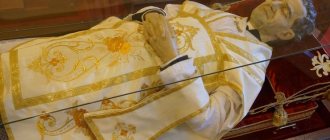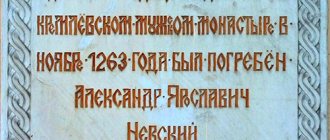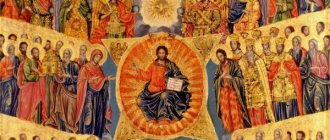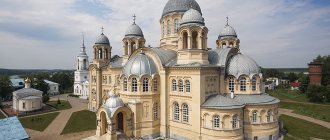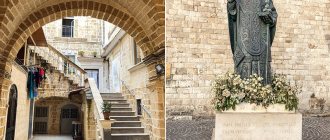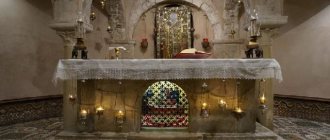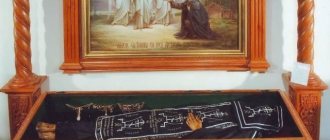Dolls, mummies and empty tombs
After inspection by the commission, it was revealed that among the relics there were five dolls. In addition to the wax Svirsky, they turned out to be Euphrosyne of Suzdal - a fabric doll with skeletal remains, Savva Storozhevsky (Zvenigorod), Kirill Novoezersky (Belozersk). The relics of Patriarch Pitirim of Tambov turned out to be bones covered in wax and placed in a metal shrine.
Three of the tombs contained no human remains at all. When checking Saint Artemy Verkolsky, members of the commission found three chests with cotton wool, church clothes, and in the last one, coal with broken bricks. According to the recollections of the participants, from what they saw, some monks began to take off their black robes and ask to have their hair cut. In the village of Voskresnoe, in the tomb of St. Paul of Obnor there were ordinary boards, old coins, construction waste and an empty jar of Brokar brand hair pomade. The tomb with the relics of Macarius Zhabynsky in the Tula province was empty.
Among the “incorruptible relics,” eight mummified bodies were also identified, most of which were badly destroyed. They turned out to be the remains of Prince George in Vladimir, Saints Theodosius in the city of Totma, Procopius of Ustyanovsky, Arseny the Wonderworker from the Tver monastery, as well as the Moscow Vilna saints (Antony, John, Efstaphy). The face of the badly decayed mummy of Euphrosyne of Polotsk was covered with a layer of an unknown brown mass.
How the communists exposed the church by opening the relics of saints
100 years ago, on July 30, 1920, the Council of People's Commissars adopted a resolution “On the liquidation of relics on an all-Russian scale,” which became the first act of unprecedented persecution of the church. After the establishment of the dictatorship of the proletariat, it was the church that remained the only place uniting opponents of the new regime. But Lenin understood that direct repression would not do - it would only increase the number of people who sympathized with her. And he decided to “expose” the priests, to undermine trust in the church as an institution. Lenin knew very well that the campaign to open the relics would be the most crushing blow to the church from the point of view of the ordinary parishioner. Vladimir Tikhomirov tells how the struggle with the relics went and what it led to.
Cult of relics
The veneration of relics as shrines dates back to the very first times of Christianity. During centuries of persecution, gatherings of Christians were strictly prohibited, but Roman law, tolerant of foreign gods, made one exception: followers of any cults and any religions could gather together to perform funeral rites. Therefore, the first Christian communities began to gather in the catacombs - on the graves of Christian martyrs, and it was on the graves that the first Christian liturgies were celebrated with the communion of the Holy Gifts. The Roman Bishop Felix in the 3rd century AD decreed that the liturgy should be celebrated only on the relics of the martyrs. At the Fifth Council of Carthage, this rule was extended to the entire Christian Church. Moreover, the cathedral decreed that no temple should be built except on the relics of the martyr, which were located under the altar. But since by that time the persecution of Christians had already ceased, there were not enough graves of martyrs for all the churches being built. Then the church fathers decided on “antimensions” - that was the name of special church scarves made of expensive brocade, into which microscopic particles of the relics of the holy martyrs were sewn. Such scarves were placed on the altar, and only on the antimension could the priest perform the liturgy with the consecration of the Holy Gifts - and this rule is still in effect in the Orthodox Church.
Altar before the liturgy in an Old Believer church | Photo: G. Chistyakov
The special role of relics in worship led to the emergence among illiterate parishioners of their own parallel cult of relics, to which the people began to attribute certain special magical properties and the ability to perform miracles. The story of the plunder of the tomb of Nicholas the Wonderworker, the bishop of the city of Myra in Lycia, is indicative, when in 1087 merchants from the Italian city of Bari plundered and opened the tomb of the saint and took away part of the bones. Perhaps they would have carried everything away, but angry locals prevented them. The second time the tomb was plundered by the Venetians, who, having learned about the “feat” of the barians, decided that with the help of the relics of the saint, the inhabitants of Bari would gain an advantage in the trade war with Venice.
It must be said that the clergy only contributed to the spread of this cult of relics, because a microscopic particle of the saint’s incorruptible body could make any icon “miraculous” and, therefore, significantly increase the flow of parishioners. Agree, it is much easier to show peasants which relics of saints should be kissed on holidays and which ones during illnesses than to patiently bring the Word of God to lost people.
Relics of St. Nicholas the Wonderworker | Photo: Mikhail Japaridze / TASS
As a result, the cult of relics among the people degenerated into a kind of mixture of pagan beliefs and primitive occultism - in a word, into something completely opposite to the spirit and meaning of the Christian faith. Thus, an expert on popular treatment, Doctor of Medicine Gabriel Popov, wrote in 1903:
An extremely interesting medical act is crawling under the shrine of St. relics and under miraculous icons. The belief in the healing properties of this act is more or less widespread in many places and is a fairly common occurrence in many religious processions. At the time of such a move, especially if some revered local icon is involved in it, the sick, adults and children are laid out along the way so that the icons can pass over them and be carried, while the healthy ones crouch down for this purpose... Another non-canonical way of using shrines, as they wrote from the ground, it turned out to be the use of revered icons for toothache. It was believed that to relieve pain the icon should be chewed...
Lenin's subtle calculation
Lenin knew the psychology of the crowd and clearly calculated the blow. The fact is that in ancient times on the tombs of saints they wrote: “lies in body” (that is, the body is completely preserved) or “lies in relics” (only bones or even individual bones are preserved, because the body of the deceased saint was first cut up to remove holy relics for church needs). This was discussed in detail in the brochures of the Holy Synod “On the Veneration of Holy Relics,” but who read these brochures if in the Russian Empire more than 80% of the population could not read?!
Therefore, even many priests who received only a seminary education treated the relics of saints based on their own ideas. And in the minds of most parishioners there was a certain axiom: relics are the incorruptible bodies of deceased saints, who should be given the same respect as icons. The key word here is “incorruptible.” And although the church fathers explained many times that incorruptibility itself should not and cannot be a prerequisite for holiness; that the holiness of a person is determined not by the degree of preservation of his remains, but by his life and service to God; that the completely decayed remains of saints also deserve respect.
But from all these explanations, the people understood and accepted only that the relics meant incorruptible. Everything else is fake and deception. So Lenin clearly played on this popular faith. He understood perfectly well that the simultaneous opening of the relics on the ground was supposed to reveal the “deception” of the church - that most of the relics, according to popular beliefs, would turn out to be “fake.”
Trial autopsies
In January 1919, the Bolsheviks began dissections as an experiment. The statistics are as follows. During the year, 63 autopsies were performed. Decayed bones or parts of skeletons were found in 29 tombs. In 16 tombs there are mummified remains of people, in 18 tombs there are wax dolls into which individual bones were inserted.
For example, such remains were found during the examination of the tomb with the relics of Saints Peter and Fevronia in Murom: “A box, 5 vertex high, divided by a wooden partition into 2 halves. Both in one and the other half there are human bones, not all of them, very few, the strongest: hips, humerus, skull.”
Cancer (tomb) with the relics of Saints Peter and Fevronia | Photo: mirtesen.ru
Nothing was found in 2 cancers.
Here, for example, is the protocol for the opening of the relics of St. Artemy Verkolsky in the Arkhangelsk province:
The coffin is divided into 3 parts, in the first part there is cotton wool, in the 2nd part there is church vestments, in the 3rd part there is a small red chest, tied with a cord and sealed with the seals of the Verkolsky monastery. Upon opening the chest, the following was found: ordinary coal, burnt nails and small bricks. There are no signs of bones.
OGPU agents reported:
The monks and Archimandrite Ioannikis were present at the autopsy. Some monks, with the words “this is how we have been deceived until now,” began to take off their monastic clothes and, throwing them into the corner of the church, said: “Enough of fooling us!” ... One of the village women, when she saw what was found instead of the relics, said: “I, a fool, came here last year and, when I approached the shrine, I was all trembling with fear, thinking that there really was an incorruptible saint here, but Look here, what rubbish has been put in place of the saint.
Also, no bones were found in the cancer of St. Abraham of Rostov. Here is a quote from the protocol:
Several boards, old coins, a jar of fixatoire, shavings, earth, wood chips and bricks were discovered.
But let’s not immediately accuse the church of faking relics. Most likely, church parishioners, having learned in advance about the Bolsheviks’ intention to perform an autopsy, simply hid the bodies of the saints, replacing the remains with whatever came to hand.
Exposure at the Lavra
When in March 1919 the authorities decided to open the tomb with the relics of the great Russian saint Sergius of Radonezh in the Trinity-Sergius Lavra, monks and parishioners began collecting signatures on a petition to the Council of People's Commissars not to open the shrines. Patriarch Tikhon himself addressed a letter to Lenin, but never received an answer.
An organized public action was scheduled for the evening of Friday, April 11, after the evening service. In view of possible unrest, a company of cadets was mobilized, posts were set up at the bell tower and cathedrals, and the entrances to the monastery were blocked by patrols of Red Army soldiers and security officers. In the presence of representatives of provincial and local authorities, members of the “technical commission”, two medical specialists, believers and monks led by the Lavra’s governor, Archimandrite Kronid (Lyubimov), the shrine containing the relics of St. Sergius was dismantled. Everything that happened was filmed; these images have survived to this day. From the protocol:
When the cap is removed from the head, a human skull is visible, partly lying on the splint, partly suspended. Near the skull, on the right, the first cervical vertebra is visible. The length of the figure corresponds to a person of average height. Jonah lifts the incinerated tissue... the lower jaw has separated. It has seven teeth. On the left lie two cervical vertebrae. Rotten clothes are unwrapped. Everything is moth eaten...
Commissioner Sergei Volkov recalled:
Already long after midnight I managed to get out through the gate at the Assumption Gate. At first I found myself among the mounted and footed Red Army soldiers who were holding back the crowd trying to break into the Lavra. Having squeezed between them and having lost several buttons from my coat in the crush, I found myself in a seething crowd of thousands. Something incredible was happening under the dark sky. From everywhere came muffled chatter, arguments, sharp cries coming from the direction of the Holy Gate, fragments of prayer singing, neighing horses, hysterical women's voices, heart-rending screams and cursing. The crowd consisted of many groups that connected, spread out, merged with others and broke up again into new groups. Seeing that I came out of the gate, several groups of women immediately rushed towards me, apparently recognizing me from the services in the academic church, where I served as church warden. -Have you been to the cathedral? What's there? What did you find? What relics?.. - The relics are intact, but only the bones of the Reverend are preserved... - He’s lying! - a man in a soldier’s overcoat interrupted me. - Instead of relics, they found a board! What started here! - Shut up, you damned one! Godless! Drive you in the neck!.. - Why are you listening to him?! Beat him! Strike! People around rushed at the man, waving their fists, and he ran...
The relics of Sergius of Radonezh were confiscated. They were returned to the church only after Stalin's decision to stop the persecution of Orthodoxy in 1943.
Opening of the relics of Sergius of Radonezh
Many years later, Doctor of Geological and Mineralogical Sciences Pavel Florensky, grandson and namesake of the famous priest, philosopher and theologian, in an interview with the magazine “Science and Life”, told a family legend about how his grandfather cut off the head of the saint with a “spear” and replaced it with the skull of Prince Trubetskoy , extracted from the family tomb under the Trinity Cathedral. When there was a threat of confiscation of the remains of Sergius of Radonezh and their destruction, Father Pavel Florensky and restorer Yuri Olsufiev, who were compiling an inventory of antiquities in the Trinity-Sergius Lavra, managed to quietly replace the head of St. Sergius and hide it. Florensky and Olsufiev themselves died during the years of Bolshevik terror, but the shrine was preserved by the priests of the Church of the Vladimir Icon of the Mother of God in the village of Vinogradovo. In the victorious year of 1945, the head of the saint was handed over to Patriarch Alexy I, and the holy relic returned to the Trinity-Sergius Lavra only in 1946.
Liquidation on a nationwide scale
It was decided to replicate the experience of 1919. And on July 30, 1920, a decree “On the liquidation of relics on an all-Russian scale” was issued.
Soon the fate of the relics of St. Sergius of Radonezh was shared by the remains of many other especially revered saints in Rus'. Thus, in the Tambov province, the district congress of Soviets decided to open the shrine containing the relics of Seraphim of Sarov. The initiator of this action was the Mordovian poet, translator of “The International” into the Moksha language Zakhar Dorofeev. Soon the confiscated relics were transported to Moscow. In the capital, they were exhibited first in the Central Anti-Religious Museum, then in the Museum of Religious Art in the former Donskoy Monastery, and later were sent to Leningrad - to the storerooms of the Museum of the History of Religion and Atheism, which was located in the Kazan Cathedral. Only in the 90s were the relics of St. Seraphim of Sarov returned to the Diveyevo Monastery he founded.
Relics of Seraphim of Sarov in Diveevo | Photo: diveevo-tur.ru
But the museum “fate” of the relics of saints did not always guarantee their safety. They could, for example, be thrown away during restoration, mistaking them for ordinary garbage in church utensils and making a note about the “change in weight” of the item.
Crayfish made of precious metals also did not live to see museums. For example, in the Donskoy Monastery, a multi-pound silver shrine of St. Alexis of Moscow was confiscated and then sent for melting down.
The authorities tried to turn the mockery of human remains into a powerful propaganda campaign. Each autopsy of the relics was necessarily filmed, so that these films could then be transported around the country and shown to people in new clubs. Moreover, in a number of cases, the autopsy was carried out with deliberate blasphemy - for example, during the opening of the relics of St. Savva of Zvenigorod, one of the commission members spat on the saint’s skull several times.
However, evidence of a different kind has also survived. Thus, the incorruptible remains of St. Joasaph of Belgorod, who died in the middle of the 18th century, puzzled even blasphemers - his relics were immediately sent to Moscow to the anatomical museum of the People's Commissariat of Health. The incorruptible relics of St. Theodosius of Uglitsky, Bishop of Chernigov, were also sent there.
Results of the “powerful” campaign
Where were the people, why didn’t they defend their church? Firstly, he defended: during the anti-church campaign of 1920, almost one and a half thousand cases were recorded when people stood up to defend shrines. Many incidents were bloody. Thus, the abbot of the Alexander-Svirsky Monastery was shot because he refused to sign a protocol stating that there were supposedly no relics in the shrine.
On the other hand, apostasy was indeed widespread. Many fell under the influence of the press - a massive campaign was launched in Soviet newspapers accusing the clergy of deceiving believers for many years.
Confiscation of valuables from churches in the 20s
The editor-in-chief of the anti-religious magazine “Revolution and the Church” Pyotr Krasikov wrote:
Now you need to clean your calendar. The worker has already taken the first step. He opened the relics - it turned out to be dust. The worker must take the second step. It is necessary to fill the calendar with proletarian revolutionary names. We have many of our own martyrs, we have something that no other religion has: heroes of labor and revolution...
The campaign to open the relics turned out to be a prelude to the actual ban and destruction of the church. Following this, a campaign began to confiscate church valuables and liquidate priests. The Bolsheviks also took up the calendar: already on May 1, 1920, the first “Red Easter” - “Mystery of Liberated Labor” - took place in Petrograd, in which more than 2 thousand people took part. And a few years later, the country of victorious atheism appeared with its own “relics” - in a special glass tomb near the Kremlin wall itself.
Incomplete skeletons and isolated bones
In the remaining 47 cases, heavily decayed skeletons were found in the tombs, most often individual fragments of bones mixed with cotton wool and the remains of vestments. For example, in a shrine containing the relics of Sergei of Radonezh, human bones were found mixed with decayed clothing, cotton wool, dead moths and larvae. Often the lack of bones was compensated for by cotton wool. The commission discovered such falsifications in Mitrofan of Voronezh and a number of other saints. The relics of Tikhon of Zadonsk turned out to be fragments of bones and cardboard painted in flesh color, and the role of the chest was played by a metal frame.
It is interesting that the Novgorod prince Vladimir turned out to be wearing factory-made boots, and among the bones of Prince Konstantin and his “children” there was a brooch with the inscription “Shura”. In the skeleton of Prince Gabriel from Yuryev-Polsky, doctors identified 2 extra temporal bones and a child’s rib.
Relics of Motrona
Such mass insanity can be observed in the Temple of the Matrona of Moscow, where the Relics of the Matrona are kept. Every day there is a line of materialistic beggars who want to beg for health, a child, money, fame, wealth, etc.
Even severe frost cannot stop our trusting people from queuing for several hours to get to the treasured coffin. What a terrible deception of our gullible citizens. Here's your ideal business! A continuous flow of worldly goods, voluntarily brought by gullible people to false churches. How else! How else can you be forced to give up your hard-earned money? Rightfully one of the best business ideas of our millennium. This is such a rotten business
The queue to the Temple of the Matrona of Moscow is waiting for miracles. Yes, truly a field of miracles in the land of fools!
Relics of Matrona of Moscow. The outside is a beautiful casket, and inside... complete bastard! Woe to you, scribes and Pharisees, hypocrites, for you are like whitewashed tombs, which on the outside seem beautiful, but inside are full of the bones of the dead and all uncleanness. Matthew 23:27 - Matthew 23:27: https://bible.by/verse/40 /23/27/
And this is not some kind of mockery of believers, it sincerely pains me to watch all this madhouse that has engulfed the whole world, but when the whisper of love does not help, the voice of reason is not heard, then the All-Good One uses the mouthpiece of suffering. Perhaps it is in this form of expression of thought that I can somehow awaken the Divine people who are ready to wake up, sober up and begin to think independently, let the rest throw stones at me.
Consequences of the audit
In August 1920, a circular was issued instructing the executive committees to carry out the local liquidation of relics, avoiding indecision and half-measures. Discovered dolls and other falsifications should be transferred to museums of atheism and criminal cases initiated against charlatans. Patriarch Tikhon admitted that church ministers were negligent in preserving the relics of saints, and local priests and monks could have lost fragments of the remains or left them in poor condition.
Tikhon decides to revive the ancient practice of checking relics and said that each bishop will be personally responsible for oversights. However, it was too late; the Bolsheviks, determined to draw the masses away from the Orthodox Church, began a deliberate policy of its destruction. In 1922, the new government would complete the destruction of the Russian Orthodox Church and confiscate church property. In the same year, Alexander Nevsky's cancer will be opened, in which 12 bones will be found, belonging to different people.
Place of the tomb for storing relics, in an Orthodox church
A church tomb, also known as a shrine, is used to preserve holy relics or to place the shroud. In shape, this Orthodox attribute resembles a coffin. For the first time such paraphernalia appeared in Christian churches, and over time it appeared in other religions. It is difficult to exaggerate the holiness and significance of this attribute in the interior decoration of the church, because it is in it that real relics and artifacts of the Christian world are stored, which are often endowed with miraculous and healing abilities.
Undoubtedly, the holy shroud, like the relics of saints, are an object of pilgrimage, and a huge number of believers flock to the temple in which these relics are located from the most remote corners of the country and even the world. In front of the tomb, prayers are offered with requests for healing, guidance on the true path, and asking for blessings to overcome life's difficulties. This is part of our Christian culture, which a believer strives to touch.
Not every temple has such significant relics of the Christian world as the shroud or the relics of a saint, because these are very rare artifacts. But a church that has such a relic deserves special treatment and worship. In a temple building, the cancer is located, depending on its layout, usually closer to the altar. The shroud can be kept either closed, under glass, or open for worship.
Valuable types of wood are used as material for making the shrine; ultimately, the wooden tomb is framed as richly as possible, which focuses attention on its holiness and significance for the church.
Among the most common and at the same time revered framing techniques, wood carving occupies a special place.
The carved tomb is decorated with complex ornate patterns, crosses, and scenes based on biblical motifs. Traditionally, such rich decoration is necessary to emphasize the symbolism and solemn significance of a church attribute.
In ancient times, crayfish were made in a simpler design; their main task was to create comfortable conditions for storing Christian relics. The masters focused on maximum protection of the relics from external influences. But with the passage of time, new materials, finishing and framing techniques appeared, and aesthetic vectors in church art changed.
A modern tomb amazes with its high-quality appearance, inspires awe and respect for the shrine preserved in it, and focuses attention on the symbolism reflected in its design. The color range here primarily uses the color of natural wood, painting in golden shades, as well as a combination of white and gold.
You can buy a tomb skillfully framed using wood carvings both in church stores and in workshops at monasteries and even in modern online stores.
Where do the relics “grow” from?
The beginning was made in ancient Egypt, but now we will not analyze down to the atoms the entire line of origin and transformation of the slave religion. Let's take the date 33 AD as our starting point. when the first Christian martyr Stephen, who came from the Jewish diaspora, appeared. After his death, terrible persecution of the Christian Church began. In Christian communities of that time, the names of martyrs were included in the lists of local churches. In some communities these lists were read out during the Lord's Supper as examples of unwavering fidelity to the teachings of Christ.
On anniversaries, believers gathered at the graves of martyrs to listen to eyewitness accounts of their martyrdom. At that time, no one had ever thought of turning in prayer to the murdered members of the community and asking for their intercession before God. In the minds of Christians of that time, such a prayer could only come from the lips of a pagan who did not know the truth, and paying Divine honors to the “remains of martyrs” (relics) would seem blasphemous.
The Second Council of Nicaea (787) approved the worship of the remains of martyrs, in defiance of Holy Scripture and the fathers of the church.
And what do we see now as a result?
As always, we have one very important question to ask here! Who benefited from all this and why? In general, this question should always be asked when considering various topics and myths, because the answers to such questions can lead us to shocking conclusions.
We can also hear from various sources about miraculous healings, changes in people’s lives, etc., etc. after contact with the relics, as well as numerous miracles accompanied by various stories, but do you really think that this is what the bones do? Only you yourself create these miracles with yourself, this is generally human nature, to create. If you wanted to, you got sick, if you wanted to, you got better. But I will continue to question absolutely everything!
See now that I alone am God, and there is no God besides Me. I kill and I give life, I have wounded and I will heal, and no one can deliver from My hand. Deuteronomy 32:39 – Deuteronomy 32:39: https://bible.by/verse/5/32/39/
Where, from whom exactly did you learn, hear, see about miraculous healings? Have you personally seen it? have you experienced? did something happen before your eyes? Can you imagine how much effort needs to be invested every second in a profitable church business in order to maintain the illusion of miracles?! What if this was your business?
the one whose coming, according to the working of Satan, will be with all power and signs and lying wonders 2 Thessalonians 2:9 – 2 Thessalonians 2:9: https://bible.by/verse/60/2/9/
Can you imagine how much effort needs to be invested every second into a profitable church business in order to maintain the illusion of miracles?! What if this was your business?
Imagine that, for example, a very pious neighbor came to your house for a visit and suddenly saw that your icon was “streaming myrrh,” and if you also come up with a beautiful legend for this and tell her, then rest assured, the next day An entire pilgrimage is being organized for you. Who will check what you lubricate it with while the pilgrimage stops for the night?
And so it is here! And if the financing of the parish depends on this, can you imagine? There are miracles - people come, there are no miracles - they don’t come and they don’t bring money. What remains? Work miracles, what else can you do!
